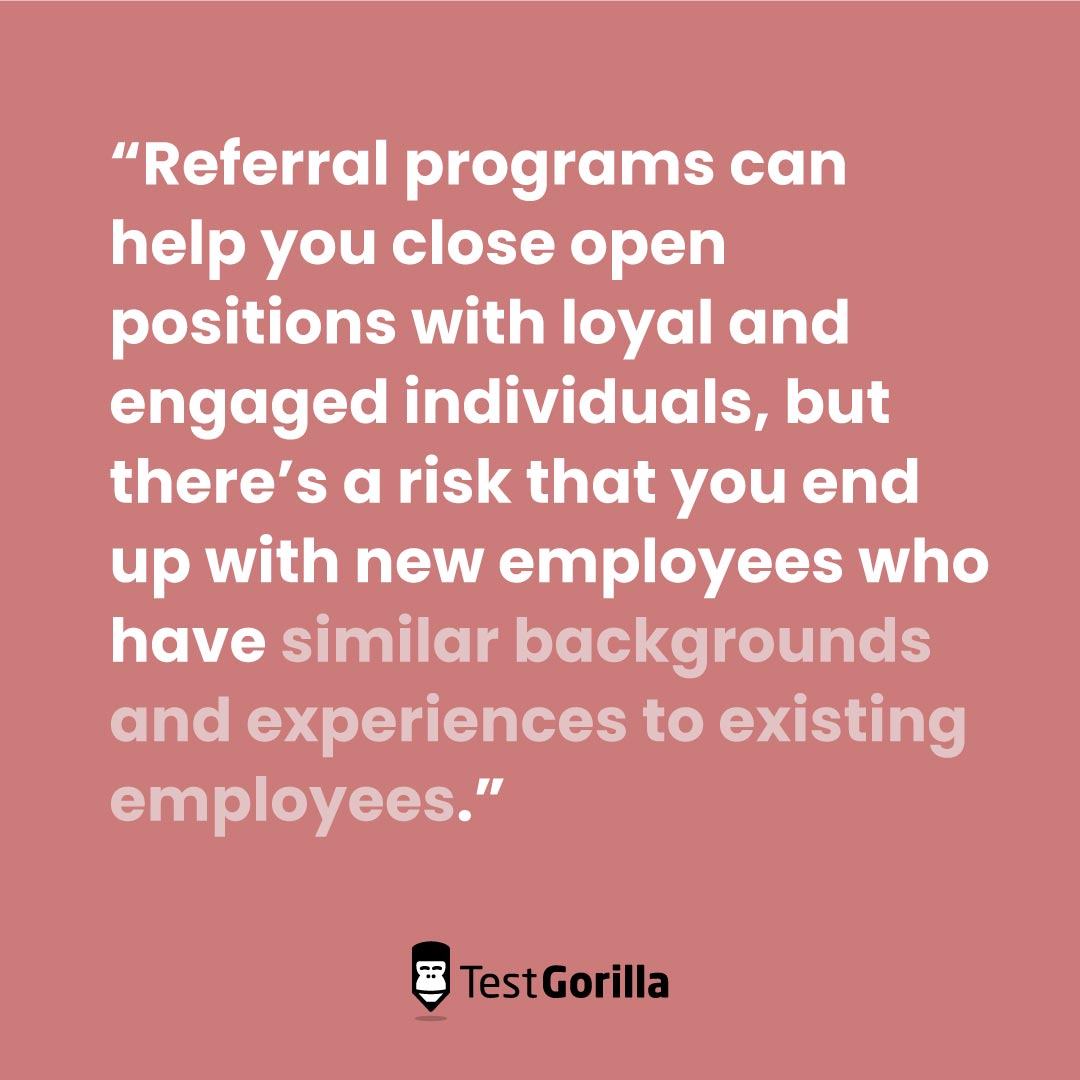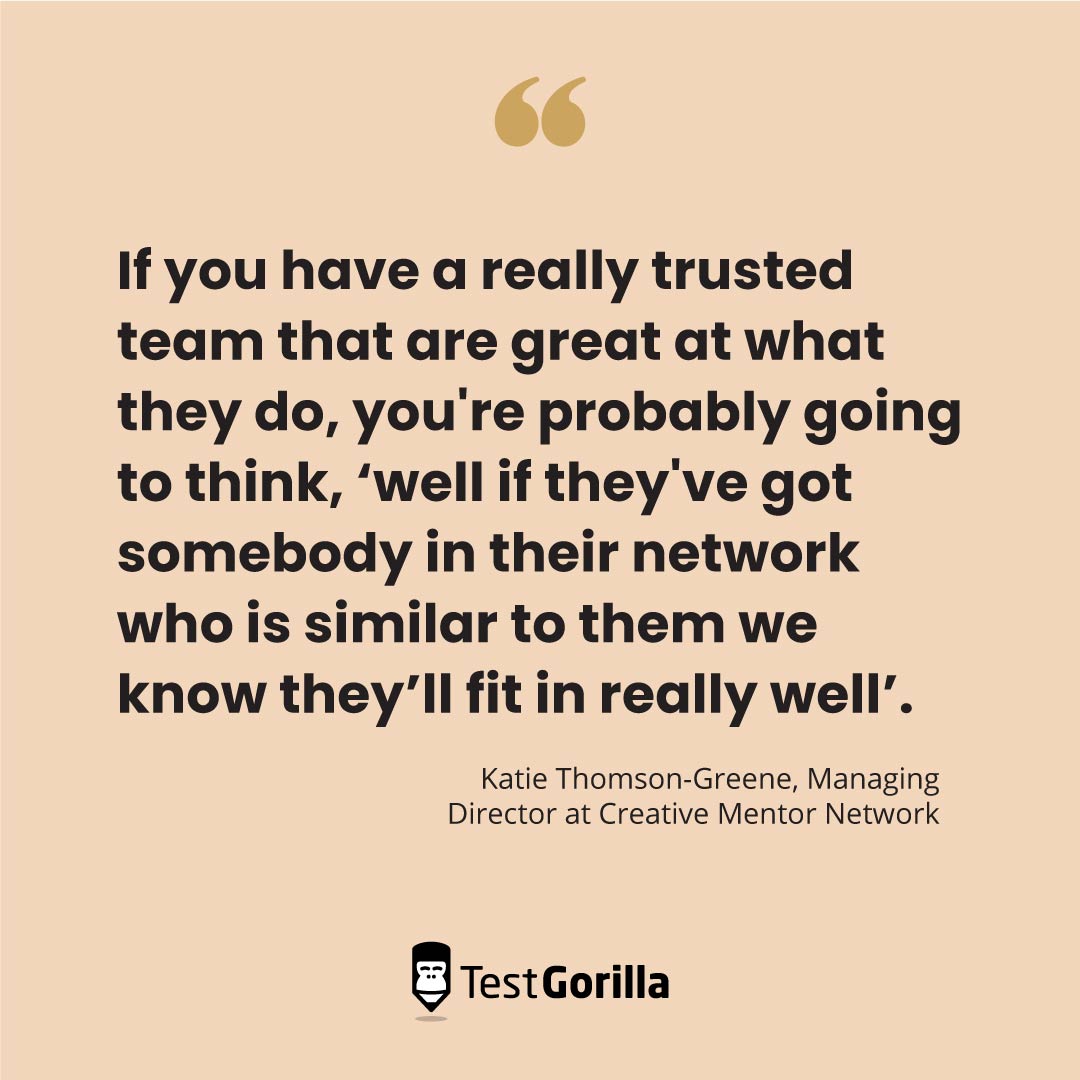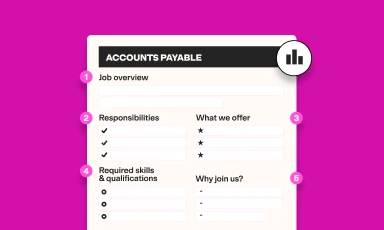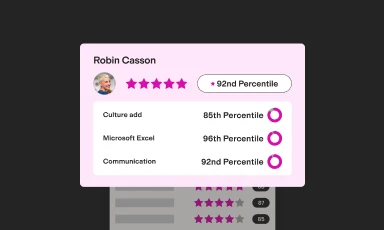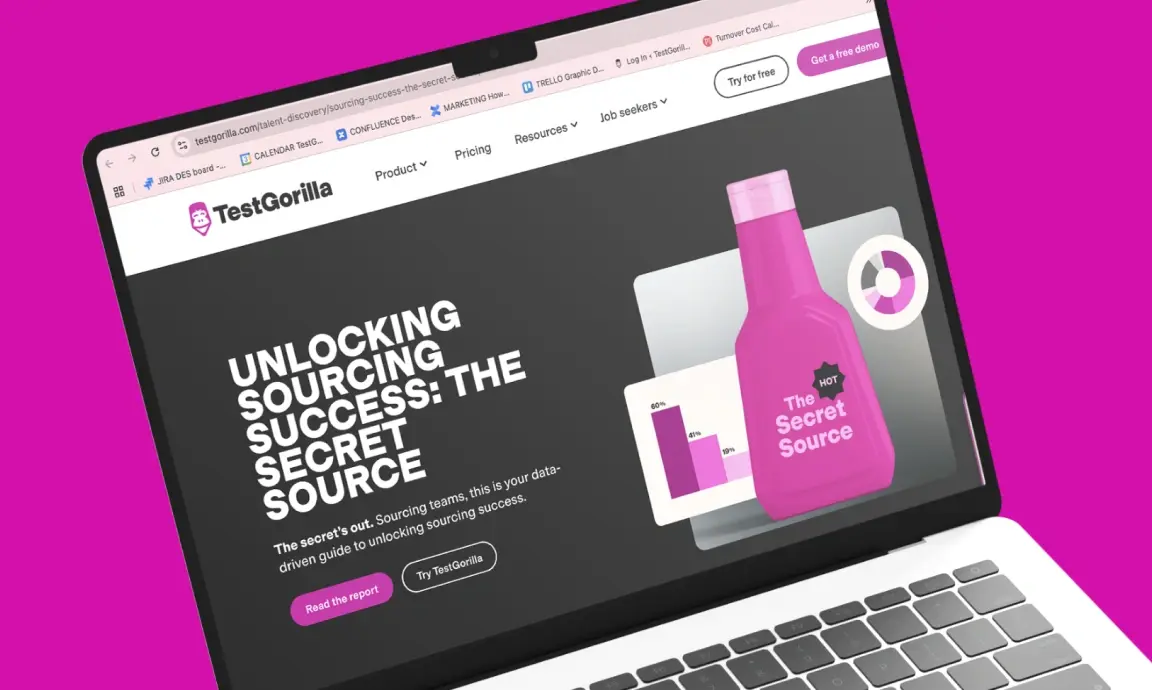It’s not just who you know: How skills-based hiring makes referral programs fairer
Recruiting a person for a role ideally means finding someone with the perfect combination of hard and soft skills, and the potential to grow professionally and add to your company culture.
Problems arise when you get culture fit and culture add mixed up – and everyone ends up looking and acting the same.
Referral programs can help you close open positions with loyal and engaged individuals, but there’s a risk that you end up with new employees who have similar backgrounds and experiences to existing employees.
This can seriously compromise diversity and inclusion (D&I), which is now a non-negotiable focus for most organizations. Not only does it help you create a welcoming culture – diverse companies are more productive and profitable. (1)
Fortunately, combining referral programs with skills-based hiring can help you achieve unbiased talent acquisition whilst still reaping the benefits of referrals.
In this blog, we’ll cover how referral programs benefit your business, how they might put diversity at risk, and the best practices you can adopt to overcome these challenges. We also include expert tips from Katie Thomson-Greene, Managing Director at Creative Mentor Network, on how to hire for culture add.
The case for referral programs
Referral programs invite employees to share job openings with people they know and who they think will “fit in” well at your company. It’s also common for employees to get a reward if you hire their referred candidate.
Companies implement referral programs because they’re less expensive than paying for job boards. Plus, referred employees are 70% more likely to stay in your company for longer so you also save on onboarding costs that come with higher turnover.[2] With this initiative, you can also reduce time spent during the sourcing and interviewing process, since you immediately get more qualified candidates in the pipeline.
While not in favor of referral programs, Katie Thomson-Greene, Managing Director at Creative Mentor Network, acknowledges their appeal. “If you have a really trusted team that are great at what they do, you’re probably going to think, ‘well if they’ve got somebody in their network who is similar to them we know they’ll fit in really well’.”
However, while referral programs help you close open positions with qualified employees faster, they may harm your D&I efforts.
How referral programs can get in the way of D&I
Referrals get everyone excited: recruiters find good matches and hiring managers close business needs faster. However, are they any good for applicants who don’t have a network that includes people at your company?
Referral programs can put diversity at risk because people tend to relate to similar individuals. Psychological terms like “the mere exposure effect” and “homophily” explain why this is the case.[3][4] As these two concepts explain, we get closer to and feel more comfortable with people who are similar to us and have a shared context.
It’s only natural that your candidates’ friends and acquaintances are similar to them. They probably went to the same school, are approximately the same age, live in the same neighborhood, or have the same political views. Although they might be a culture fit, they probably won’t be a culture add. And culture add is directly connected to diversity.
“The first thing recruiters might think of is, ‘Does this person fit into the team?’ ‘Can we picture them getting on with everyone, eating lunch, and going to the pub on a Friday?’ And, actually, they should think about what someone brings to the role and the organization even if that’s something completely different.”
Katie Thomson-Greene.
Diversity brings benefits to your business. Diverse companies are quicker to face challenges, recruit top talent, and serve consumers better. Additionally, businesses with more than 30% of female professionals in executive positions are more likely to perform better than competitors with 10%-30% of women in the same positions.[5]
When looking at applications, recruiters shared that the second thing they pay most attention to after checking job experience is whether they’ve been referred by an employee. This is a good thing to do if you have a referral program in place to reward the right person based on internal program guidelines. However, it’s risky because you can miss out on bringing in different voices and skills.
The question is: How do you combine referral programs and D&I, and get the efficiency of referred applicants while still hiring for culture add?
The answer? You let skills-based hiring level the playing field.
The best insights on HR and recruitment, delivered to your inbox.
Biweekly updates. No spam. Unsubscribe any time.
Advantages and disadvantages of referral programs
We’ve covered some advantages and disadvantages of referral programs already. Here are a few additions to keep in mind.
Advantages of referral programs:
The hiring rate for referred individuals can be as high as 32.4% depending on the industry
Employee referral programs are the second biggest source of new hires just behind hiring internally for open positions.
Referred hires stay for longer at companies.
It’s more cost-efficient to pay for a referral program than for promotion and job board subscriptions.
It’s almost 30% faster to hire referred applicants than ones coming from career boards.[2]
New employees get onboarded and adapt to the workplace faster because they have someone they know at work
Disadvantages of referral programs:
Online experts guess that around 80% of jobs go unadvertised and are instead filled through networking, referrals, or internal hires. This means people who aren’t represented in your company will struggle to find an opening there.
Referral programs limit your talent pool and make it harder for you to widen your reach and find candidates that represent culture add.
Without a fair recruitment process, referral programs can lead to giving recommended candidates an unfair advantage.
Six best practices for keeping referral programs fair
Although referral programs have downsides, there’s no need to eliminate them altogether.
Instead, try mixing hiring methods together to provide a fairer, more diverse, and inclusive process. Here are six best practices to help you achieve that.
1. Use talent assessments
Each job requires different skill sets, and you should be able to test them all in a fair and standardized manner. Talent assessments allow you to do just that by creating custom tests for each open position – and testing a mix of soft and hard skills, culture add, and motivations. Evaluate job-specific skills like PostgreSQL or how they create a brand strategy. You can even test their business ethics and compliance with TestGorilla.
Combining referral programs with skills-based talent assessments puts all candidates up for the challenge. This way, if you end up hiring a referred applicant, it will be because they’re the best person for the job.
2. Check candidate data
It’s crucial to check if the referred candidate is actually qualified for the job. Often hiring managers or recruiters will simply hire a person who comes highly recommended by a top-performing employee.
Sometimes you just need to double-check your motivations. “I’ve almost had to retrain my brain when interviewing people to think: Why am I leaning towards this person? Is this person going to bring something new to the team?” explains Katie. Talent assessments give you concrete data on what a candidate’s skills actually are. If you’re leaning towards someone but their test results show that they lack the skills you need, then check yourself.
3. Don’t give referrals an advantage
There’s no industry standard on how much weight referrals have in the hiring process, but most people will at least consider referred candidates. This is a way of giving them an advantage over other qualified applicants.
A way to overcome this is by ensuring you have an internal hiring process and that everyone goes through it – regardless of who they know. Implement skills-based hiring or review blind resumes so you’re able to test each one without knowing their name.
Skills-based hiring allows you to increase diversity and retention and reduce mis-hires, time to hire, and hiring costs. Plus, it gives you the possibility to see your candidates shine for themselves. According to our 2022 State of Skills-based Hiring report, 70.2% of candidates agree that putting their skills to the test would increase their chances of getting their dream job.
4. Recruit for culture add, not culture fit
When you hire for culture fit, you want your newcomers to share the same values, behaviors, beliefs, and even sense of humor as the people in your company. When you seek culture add, you offer jobs to people who can bring a unique and fresh perspective to the team. Katie elaborates: when you hire for culture fit instead of add, meetings become “an echo chamber, where everyone is repeating the same thing.”
You don’t want a team where everyone thinks and acts the same. Imagine you’re a marketing agency working for an airline that wants to reach a new demographic: same-sex, first-time parents. If everyone in the room is straight, has straight parents, and straight friends, it’s likely that they won’t come up with the most relatable marketing campaign. Not because they aren’t talented, but because they lack personal experience. If you have a diverse workforce, you can transform your business, innovate, and provide better and more effective proposals that wow your clients.
5. Prioritize D&I
Putting D&I first doesn’t mean you should overlook other areas.
When we talk about prioritizing diverse and inclusive hiring, we mean you should guarantee that your processes are accessible to anyone regardless of their backgrounds or privileges — this is key to building a people-centric organization.
Focusing on D&I also means hiring from all races, genders, and identities so that you can create a safe space where everyone feels represented. It’s important to show your candidates that you care about their development and will give them all an equal opportunity.
“If you go to an interview and as you walk into a building you don’t see yourself represented at all, you’re not going to stick around. You’re not going to feel comfortable or supported. You’re not going to feel developed because you’re not going to see yourself represented in that team.” – Katie Thomson-Greene.
6. Widen your referral net
You don’t need to get rid of referral programs to prioritize D&I. On the contrary, you should make sure your referral net itself captures diverse talent. A good way to do this is by widening your network. Invite clients, suppliers, freelancers, or building personnel to recommend people for a job so you can access talent in underserved communities.
Another way to do this is by rebranding your referral program. Encourage employees to refer close friends, but also, acquaintances from all paths of life. Additionally, get all departments involved. For example, instead of getting salespeople to recommend candidates for a sales position, get everyone in the company to do it.
Publish job openings, get the word out there, encourage your employees to refer, and evaluate candidates fairly using skills-based hiring. Our studies show that 91.2% of organizations that use skills-based hiring saw an increase in diversity.
Beat the referral problem with skills-based hiring
Referral programs enhance retention by bringing in loyal employees, but a business that relies mostly on referrals can turn into an echo chamber of culturally similar team members.
To recruit someone with the skills, potential, and a unique point of view without disregarding referrals or undermining your D&I efforts, make sure all applicants follow the same process. You can also try using blind resumes to avoid giving referrals an advantage.
Implement skills-based hiring to lead fair and unbiased recruitment, value culture add over culture fit, and put D&I at the center of your business. These will make people feel represented and encouraged to share a unique point of view. Lastly, allow people outside your business to refer jobs to reach a wider and more diverse audience.
When you combine referrals with skills-based hiring, you get diverse candidates who will stay loyal – and will also challenge the status quo.
Diversity and inclusion starts with your job posting. Use skills-based assessments to hire the best candidate despite who they know – or what they look like.
Download the State of Skills-based Hiring 2022 report to learn more
Sources
[1] “Data-Driven Diversity.” Joan C. Williams and Jamie Dolkas from Harvard Business Review. Accessed on May 3rd, 2023. https://hbr.org/2022/03/data-driven-diversity
[2]“Staffing Agency Guide. Referral Program Best Practices & Benchmarks. Learn How to Create and Manage a Referral Program That Delivers Results, 2022.” Staffing Referrals. Accessed April 27, 2023. https://staffingreferrals.com/wp-content/uploads/2022/03/Referral-Program-Best-Practices-and-Benchmarks.pdf
[3] “Mere Exposure Effect: How Familiarity Breeds Attraction.” Kendra Cherry from Verywell Mind. Accessed April 27, 2023. https://www.verywellmind.com/mere-exposure-effect-7368184
[4] “Homophily” ScienceDirect. Accessed April 27, 2023. https://shorturl.at/ctx16
[5]“Diversity wins: How inclusion matters.” McKinsey & Company. Accessed April 27, 2023. https://www.mckinsey.com/featured-insights/diversity-and-inclusion/diversity-wins-how-inclusion-matters
You've scrolled this far
Why not try TestGorilla for free, and see what happens when you put skills first.


